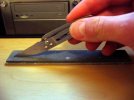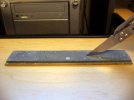Does anyone know what the original purpose of the wharncliffe blade design was? Although I don't own any knives that have a true wharncliffe point I'm thinking about getting one in the future.
I'm also interested in the original purpose behind the different blade shapes in general (i.e. drop point, spear point, tanto, etc.) Anyone that knows anything about this type of history is welcome to post a response. Thanks.
I'm also interested in the original purpose behind the different blade shapes in general (i.e. drop point, spear point, tanto, etc.) Anyone that knows anything about this type of history is welcome to post a response. Thanks.


